
How do you design a user adoption strategy to attract a new user? How do you improve your existing user adoption strategy? These are key questions that face SaaS companies. Onboarding new users and keeping existing ones satisfied is key to success, and without a comprehensive strategy that addresses both, a SaaS company can't succeed.
In this blog post, we'll address a key question: What happens after you've acquired a user? What happens after the princess marries her prince? Just ensuring users sign up once for your services isn't a successful business model. You must do the hard work of introducing customers to existing and new features, help make your service an integral part of their workflow, and ensure they remain committed to your business.
This task should be central to your business model. From keeping them invested in your service to improving feature adoption rate, we'll go over practical strategies and tips you can adopt to increase the value your business gets from your customers!
What Is the SaaS Product Adoption Process?
Product adoption is the second step in the customer journey. It comes after you've successfully acquired the users. The process includes multiple stages of the customer lifecycle: The user onboarding process where you introduce newly acquired users to your services. Active customer support where you help customers derive value from your product and help integrate it into their business/workflow. And lastly, creating custom approaches to different customer segments and trying to maximize the customers' lifetime value.
Why Does the Product Adoption Process Matter?
SaaS companies require a product adoption strategy. Just convincing a user to sign up doesn't mean automatic customer success. You need a coherent approach to each stage of the customer journey.
But talking about the necessity of a strategy might not be very convincing, so here are just some benefits you can expect from a competent product adoption process:
#1 Increasing User Adoption Rate and Improving Customer Retention
A great onboarding process, consistent follow-up, and a catered approach ensure your customers see the value of your services, going from being curious signing up for a trial or one month to being committed to using your services regularly.
This also naturally increases customer retention rates. It is much easier for users to cancel their subscription after a month when they've barely used your services. After a year, when your service is an integral part of their business processes, discounting with you will become arduous.
#2 Increasing Customer Lifetime Value
Depending on the industry, a new customer acquisition cost is 5 to 10 times higher than keeping an existing one. This is especially true for SaaS companies that usually have a B2B model and the upfront cost of getting a user to adopt their services is even steeper.
A product adoption strategy, by improving retention rates, helps improve the customer lifetime value (CLV), which is the total value your business can expect from a customer. Though it varies by sector, maximizing CLV is far more sustainable than solely focusing on customer acquisition. Ideally, both approaches go hand in hand, however!
#3 It Helps the Business Expand
Increasing customer lifetime value gives your business the capital it needs to adapt, improve, and expand. A competent product adoption strategy that improves retention rates will give you the tools and revenue streams you need to launch more aggressive acquisition campaigns, expand into new markets, and introduce new features. It makes your balance sheets healthier and makes you more competitive.
Key Tips to Improve Product Adoption and Retention Rates
A product adoption process isn't a magic pill to success. Its advantages are real and meaningful, but the process is also complex, time and resource-intensive, requires research and expertise to properly implement, and needs constant tuning and improvement.
Here are some tips that will help you to take the very first steps to create your company's very own product adoption strategy:
#1 Define the Benefits of Your Product and What Problems It Solves
Defining the benefits of using your SaaS product and how it solves the customer's problem is an essential first step in ensuring successful user adoption. It sets the stage for why customers should use your product and how it can benefit them, which you will rely on in your marketing, messaging, web design, and more.
It's essential to understand that customers are always looking for products that can help them solve their problems or meet their needs. You need to communicate both what your service does and how precisely it can help solve their problems.
An effective way to do this is to create a value proposition that clearly explains how your product can solve your customer's challenges. Your value proposition should be concise and easy to understand, clearly communicating the main benefit of using your service.
For example, if you are offering a project management tool, your value proposition might be "Streamline project management and collaboration with our easy-to-use tool." This communicates the main benefit of the product and makes it clear why a customer should consider using it.
#2 A Simple, Friendly On-boarding Process Is Essential
Creating a user-friendly onboarding process that guides users through the service step-by-step is an essential aspect of ensuring a service is successfully adopted by a user.
The onboarding stage is the first interaction a customer has with your product. Therefore, it's critical to create a positive first impression by making the onboarding process as seamless and user-friendly as possible.
One effective way to create a user-friendly onboarding experience is to use a step-by-step approach that guides the user through the key features of the service. This can include creating interactive tutorials or videos that demonstrate how to use a service's various key features or providing a guided tour of the service's interface.
An important aspect of creating a user-friendly onboarding process is to keep it simple and avoid overwhelming the user with too much information at once. You should focus on the most essential features of the service and highlight how they can benefit the user. If you are marketing to different groups, you can also try customizing the onboarding process for different types of users focusing on different features and using different jargon.
#3 Make the Pricing Model Clear and Transparent
The pricing model can significantly impact a customer's decision to use your product. It's critical to create a flexible pricing model that can appeal to different customer segments.
Offer flexible pricing options that cater to the needs of different customers. This can include offering different pricing tiers based on the customer's usage or offering discounts for annual or long-term contracts. It is important to make sure the pricing matches the perceived value from your product they feel they obtain. A new user won't be willing to pay as much as power users, and this needs to be taken into action when developing your SaaS user adoption strategy.
To demonstrate value to prospective users, it is important to provide detailed information about the features and services included in each pricing tier. This can include creating a pricing page that clearly outlines the features and services offered at each price point, as well as any limitations or restrictions associated with each tier.
You should ensure that your pricing model is easy to understand and navigate. This means using clear and concise language, avoiding technical jargon, and providing clear calls to action that guide the customer through the process.
#4 Take Individualized Approaches to Different User Segments
As your business grows and becomes more successful so will your client base. Though a single unified approach works in the early stages, due to fundamental differences between your users and their needs and expectations, you quickly need to segment them and create custom approaches for each segment.
Here are some of the most common user segments SaaS companies deal with: Early AdoptersEarly adopters are the dedicated core of your client base. They've stuck with you for years, and they are usually a substantial part of your revenue stream representing anywhere from 10-50% of monthly income.
Due to their low maintenance, many companies take this segment for granted. This can be a critical mistake as the loss of early adopters is a devastating blow to most businesses. Whether it is through feedback surveys or loyalty programs and initiatives, you should always have a read on how your early adopters feel about your services and the direction of your company!
Power UsersPower users take advantage of niche features your service has to offer. They are the quickest to notice bugs and shortcomings, and they are more demanding of customer support than other segments. Power users generally don't have brand loyalty, either. If they see your competitors are doing things better, they might leave without a second thought.
All of this might lead you to conclude they're more of a hassle than they're worth but appealing to power users is part of any effective user adoption strategy. Power users are more likely to purchase higher-tier subscriptions, they are more likely to spread information about your service through word of mouth, and they lend credibility to the value your services provide. They're part of the ecosystem, and you need to cater to them!
New UsersNew users are at the initial stages of the product adoption curve. It is true they've signed up, but they are probably still not entirely convinced of the value of your services. Creating a dedicated strategy to on-board new users is key to improving user adoption rates.
A smooth initial onboarding is key here. Tutorials that introduce users to the service's features, a comprehensive catalog of guides and documentation, and an active customer support team: There are many ways to make sure the initial onboarding phase is painless!
At-risk UsersUsers who are unsatisfied with your services, and are thinking about ending their contracts or unsubscribing from your services, are classified as "at-risk users." As we mentioned above, acquiring new users is far more expensive than keeping existing ones. A strong user adoption strategy has to include a comprehensive approach to at-risk users.
Starting by identifying why your users are dissatisfied with your services is key. Are the prices too expensive? Does your service lack certain features? Is the support your company provides not up to their standards? Not all issues can be addressed, but even small changes can encourage users to stay with your company!
Segment Clients Based on the Utility the Categories ProvideAn important point to keep in mind is that there are no concrete, set-in-stone ways to segment your users. It entirely depends on your business, sector, and industry. For a company, segmenting users by age might yield excellent results, for another, it might not make an ounce of sense. Understand your clients, learn where the faultlines are, and segment them based on real differences in needs or expectations.
#5 Offer Trials, Demos, Free Versions of Your Software
Offering a free trial or a free version of your service will encourage customers to try your product and increase the chances of successful customer acquisition. They can provide potential customers with a risk-free opportunity to experience your product and determine whether it meets their needs and expectations.
A free trial can be a powerful marketing tool for SaaS products. It turns potential customers into product-qualified leads (PQLs). Individuals and businesses who have experienced and driven value from your product's features and functionalities. This can help to build trust, establish credibility, and increase the chances of converting the prospects into paying customers.
Studies and industries differ, but PQLs are generally acknowledged as having far higher conversion rates than potential users who just read about what your services have to offer.
#6 Continuously Monitor Important Metrics and Take a Data-driven Approach
Continuous improvement is essential for a successful user adoption strategy. You should constantly evaluate and improve the product based on customer feedback, industry trends, and emerging technologies to ensure that it meets the changing needs of existing and new customers alike.
The SaaS market is constantly evolving, and customers' needs and preferences are constantly changing. If you want to have a high customer retention rate while successfully appealing to new users, but it can be difficult to strike the right balance, and below, we'll present some solutions:

A Comprehensive Data-driven Strategy Based on Key Metrics
One effective way to continuously improve the product is by gathering data and analyzing important metrics. These can range from adoption metrics you can use to measure performance to bounce rates to indirectly measure engagement. These metrics all have unique purposes and can be used to improve the adoption process.
For example, customer lifetime value (CTV) helps you measure the amount of money you can reasonably expect from a lifetime customer, you can use this figure to gauge how much is reasonable to spend on new user adoption. If customer lifetime value is significantly higher than the customer acquisition cost, it means you're doing great!
Industry Trends Are Important
It's important to stay up-to-date with industry trends and emerging technologies. This can include attending industry conferences, reading industry publications, and monitoring social media to stay informed about the latest trends and technologies that are relevant to your product. If you're running a SaaS business, you're dealing with ever-evolving client demands, and staying up to date with new trends is essential to design an adoption strategy to attract new customers.
Rolling Out Updates and Changes
Doing research and staying up to date with the latest trends are meaningless if you don't act on this information, and that's why continuously updating your software, introducing new features, and making changes to existing ones are essential for a user adoption strategy.
How you go about this can take many forms depending on your business. It can include setting a regular schedule for updates and enhancements, prioritizing updates based on customer feedback and business goals, and allocating resources and budgets to support product development efforts.
Communicating With Existing Customers
It's important to communicate product updates and enhancements to your customers effectively. This can include providing release notes, updating product documentation and training materials, and using targeted marketing campaigns to promote new features and enhancements. This not only works as a SaaS user adoption strategy creating excitement around your service, but it also satisfies existing customers.
#6 Use Feedback to Improve User Adoption Strategy
Using customer feedback is a critical component of a successful user adoption strategy. By listening to your customer's needs, concerns, and feedback, you can gain valuable insights that can help you to improve your product and enhance adoption rates while lowering customer acquisition costs.
- Identify pain points
Feedback can help you to identify pain points. Pain points could be anything from a feature having confusing UI to power users feeling like they're not getting enough out of a premium service. A SaaS company simply has to know what are the most common issues facing their users. In many instances, your clients will be happy to tell you themselves, you just have to listen to them - ask for their feedback!
Of course, all complaints can't be addressed. Some users will not be happy about the pricing, but it might not make economic sense to change it. Still, the knowledge is valuable, and in the instances where you can address the issues, you'll improve the user experience and boost user adoption.
- Rely on Feature Adoption Rate
Asking for feedback and measuring the feature adoption rates can help you prioritize which features to develop or update. By understanding which features are most used by your customers, which features your users deem the most valuable, and which features new users care the most about, you can focus your development efforts on the areas that will have the biggest impact at all stages of the product adoption curve.
- Optimize Pricing
Feedback can provide insights into how your pricing model is perceived and whether it is a barrier to user adoption. By understanding the pricing concerns and preferences of your customers, you can adjust your pricing model to increase user adoption rates.
- Improve User Onboarding Procedures
Do you want to learn which areas of your onboarding procedure are effective and which ones fall flat? Feedback is an excellent way to learn more about new users' experiences and improve the customer onboarding strategy.
By improving the onboarding process, you can help new customers get up and running with your product more quickly, which increases user adoption rates. SaaS companies pay special attention to their onboarding strategies, and it is for good reason.
#8 Offer Reliable and Quick Customer Support
Customer support is important at every step of the customer journey. New and potential users need quick, helpful, and reliable support to have their key questions about your services answered and their concerns addressed. Even if you already have a thorough onboarding process with interactive tutorials, comprehensive guides, and easily accessible FAQs, a new user is bound to experience technical difficulties, problems, and plain confusion.
Existing users need comprehensive support, as well. It is a way to demonstrate your commitment to your client base and ensure they make the most out of your services. In a B2B context, many larger businesses require you to provide commitments to ensure reliable support before they even consider your service as a candidate!
A comprehensive product adoption strategy needs to take this into account by ensuring quality support is always available at all stages of the customer's lifecycle.
- Releasecat Team

STREAMLINE YOUR SOFTWARE RELEASE NOTES WITH RELEASECAT
Also check out our other articles:

